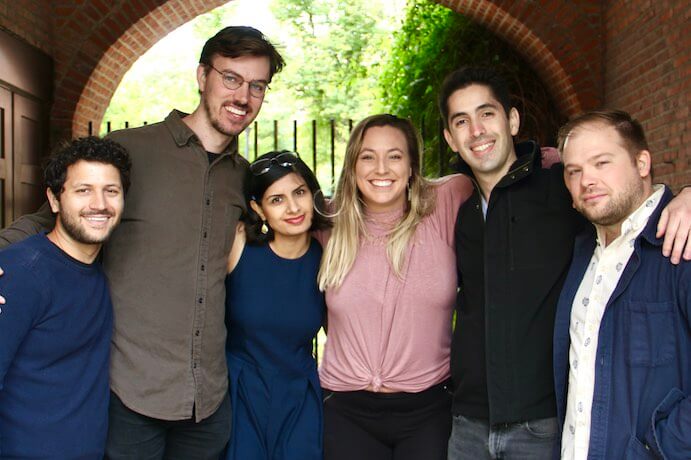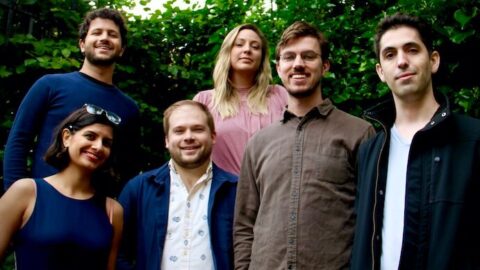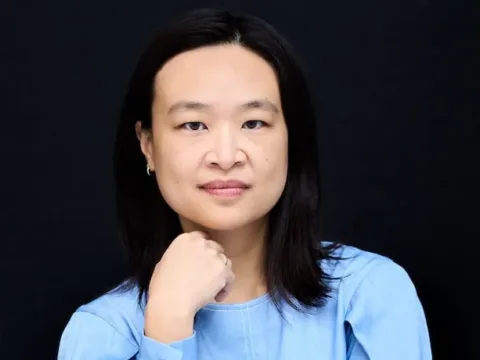Founded in 2017 by Niloufar Nourbakhsh, Ensemble Decipher (Nourbakhsh, Joseph Bohigian, Robert Cosgrove, Eric Lemmon, Chelsea Loew, and Taylor Long) is a modular, experimental music group that utilizes a wide array of vintage and new technologies to highlight new ways of listening. Commissioned works have featured the ensemble playing on rocks with accelerometers attached, boxes using machine learning to react to touch, and more traditional acoustic and electronic instruments. Ensemble Decipher’s current season features numerous new works and collaborations with composers Kamala Sankaram, Paul Leary, Jose Tomás Henriques, Jamie Leigh Sampson, Daria Semegen, and Mari Kimura through the SUNY PACC Prize and a USArtists International Grant.
What types of “vintage, contemporary, and emerging technologies” does Ensemble Decipher use, and what was the impetus for blending these?
We have used accelerometers attached to rocks, antique wooden boxes trained via machine learning to respond to our touch, Mari Kimura’s MUGIC sensor inside a dog toy, 52.1 channel speaker systems, vocoders, networking technologies for telematic performance, sonic games coded in Python for players on a local network, video game joysticks, contact microphones, acoustic instruments, and a plethora of other software and hardware with our laptops.
It is not lost on us that technology is an ever-shifting modality and how the meaning of yesterday’s technology can be reimagined in new contexts. Margaret Schedel wrote us a piece that recontextualizes Pauline Oliveros’ Apple Box Orchestra; what does this beautifully contact-amplified piece mean with the aid of recent discoveries in machine learning? Daria Semegen wrote us a piece where we are recreating reel-to-reel tape techniques with live processing — something that would have never been possible at the time when tape machines were primarily being used. This blending is not for nostalgia. It is an innovative approach that integrates the unique and important technological objects of the last half century as part of the musical canon.
One of your goals is to “challenge the power structures that lace the field of electroacoustic music.” What are these power structures, and how is Ensemble Decipher changing the culture of the electroacoustic field?
Electroacoustic music has a history of being exclusionary when it comes to class, racialized and gendered hierarchies, and higher education access. For example, performing and writing electroacoustic music often requires a great deal of gear, and gear costs money (which can be quite expensive). Most people simply do not have the means to access the tools necessary for the medium. Likewise, according to the National Center for Education Statistics, those obtaining degrees in music tech in the US are predominantly white and male, as are those with careers in the industry according to the Bureau of Labor Statistics and US Census data. This reality reflects the exclusion of women and people of color in the tech-sector more broadly. Traditional power structures are also linguistically prohibitive. If you want to code your own sound synthesis software, many modern programming languages’ syntactical features and documentation are simply written in English — the most widely spoken language (native and as a second language). This speaks to the history of colonialism.
The question is then, what can we do about it as a group concerned with justice? We don’t presume to claim that Ensemble Decipher is going to deconstruct colonialism or the sexist and racist structures within society on our own. Instead, our job as a new music ensemble should be to pull bricks out of each of these barriers by offering opportunities and opening up possibilities within the field itself. For us, this has meant supporting organizations working at the community level on access for music education like Lift Music Fund, engaging in conscientious commissioning that reflects the breadth of voices working in contemporary music today, and collaborating with composers who don’t necessarily center their practice in the “electroacoustic” music space. This involves bringing our technologically focused performance practice to them so that what we do serves their voices.
We also like to think about how the act of performance in and of itself constitutes a form of exclusion. Recently, we put together an installation for New Music Gathering called A Community Sonified that was collaboratively composed and coded by members of the ensemble and our friend Omkar Bhatt. The software for the installation both synthesized music and issued performance instructions to Joseph, Niloufar, and Chelsea based on the anonymized contents of participants’ chats. The audience then had a role to play in creating the music rather than merely participating in a work by engaging in the traditional concert-going sensibility of listening. We see our creative process as continuing the deconstruction of traditional relationships in concert music that has been carried out by figures who have inspired us, like Pauline Oliveros.

With the large amount of sounds available to you, your performances span a wide array of aesthetics. What would you say is Ensemble Decipher’s “style,” in whatever way you define that term?
We tend to focus on music that explores unique modes of performance rather than a single aural aesthetic. We’re particularly interested in using technology in an embodied way, such that our movement is an integral part of the performance, rather than spending an entire concert typing on our laptops in the dark. With most of our pieces, we’re basically learning to play, and sometimes building, a new instrument. For example, for Mari Kimura’s KISMET, we run around the stage with a dog toy with her signature MUGIC sensor embedded, and we spent a lot of the rehearsal time for that piece focusing on the details of our movement and how it affected the resulting sounds. In a piece by Sophia Sagaradze, our faces become instruments. In that piece, a camera tracks our facial expressions which control the electronic processing of viola sounds. These pieces come with their own unique challenges (like dry eyes from repetitive blinking), but they both focus on the interaction of the performers’ physicality with the technology.
Ultimately, our goal for any piece is to work collaboratively with the composer to best realize their vision and share that with our audiences. The scores themselves are just one tool in this collaborative process.
How does preparing works that use differing degrees of improvisation, traditional scores, and non-traditional scores/compositional planning affect how you interpret and perform together?
The variety of approaches that we deal with doesn’t drastically affect our performance or interpretation. Ultimately, our goal for any piece is to work collaboratively with the composer to best realize their vision and share that with our audiences. The scores themselves are just one tool in this collaborative process. For example, when a piece heavily involves improvisation, we first talk as a group about how we envision the structure and shape, rehearse different options, then get the composer’s feedback. These different compositional approaches do help us choose a “point person” for each piece. Our ensemble members have varying skill sets; the majority of us are composers with a background in performance (piano, percussion, viola, voice) and a couple are primarily performers (both percussion) with a background in composition. In addition, we have varying degrees of experience with different types of technologies. We take all of this into account when choosing someone to take the lead on explaining how a piece works and guiding rehearsals. We are also excited about pieces that involve technologies we don’t have much experience with, in which case the point person takes time to learn how the tech works and teaches the group during rehearsals.
What have your extensive list of collaborations taught you about achieving your goal of changing the electroacoustic community?
We have consciously worked with composers who have different experiences with music technology for two reasons. On an artistic level, this has resulted in repertoire that is varied in its aesthetics and approach to composition and performance. By taking this approach, we want to challenge and expand both our own and our audience’s ideas about virtuosity in contemporary music. The idea of a computer as a musical instrument has expanded the concept of performance, and consequently, what is seen as virtuosic. The instrument (computer) itself is evolving at a fast rate, and mastering this instrument as a virtuoso is completely different from mastering an acoustic instrument like the piano, which evolves at a much slower rate. Such a contrast allows space for experimentation as well as redefining old concepts and conventions in our field.
This perspective also strengthens one of our important educational goals; to increase accessibility in composing electronic and electroacoustic music. Many of our own members had very limited experience with music technology before joining the ensemble, and we were able to gain technical skills together through performances of varied repertoire and commissioning new works. We want to create a supportive environment in which composers are unafraid to try something new in the computer music field. At times, this could mean that a project’s idea does not work as it was imagined, and we’ve all had our fair share of technology not doing what it’s supposed to be doing, but that’s just part of the process.
I CARE IF YOU LISTEN is an editorially-independent program of the American Composers Forum, funded with generous donor and institutional support. Opinions expressed are solely those of the author and may not represent the views of ICIYL or ACF.
A gift to ACF helps support the work of ICIYL. For more on ACF, visit the “At ACF” section or composersforum.org.
























